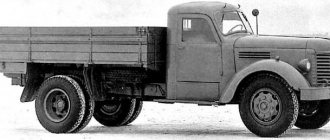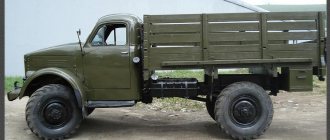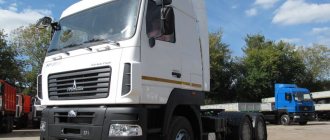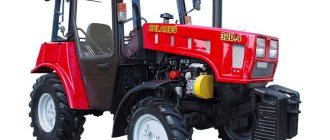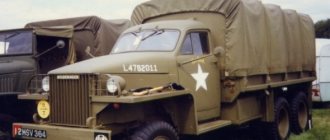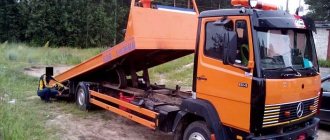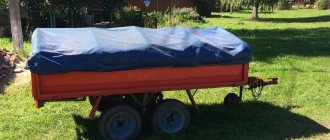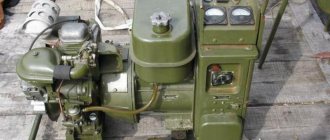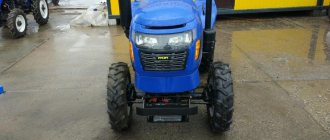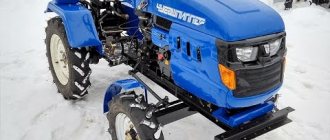Sixty is an age that deserves respect. Even in a human life, this is a considerable period of time, let alone the much shorter automobile age. Collectible elite supercars and executive cars of important people and celebrities mostly survive to this age. But there are exceptions to this rule!
Daniil Minaev, photo by the author
Early on Saturday morning I went to the southeast of the Moscow region, in the direction of that famous Meshchera, glorified by the writer Paustovsky. My colleague told me that a ZIS-151 veteran is still working in a small private farm. And this turned out to be absolutely true. When we were returning home after the retrotest of the ZIS, we met a dump truck on a GAZ-51 chassis. Absolutely serviceable, ready to deliver bulk cargo to your dacha at any moment... Mysticism, and that’s all!
The mystical series of events of that day was a foregone conclusion. No matter how much I test old cars, none of their stories repeat themselves. The only thing that makes automobile biographies similar is their typical youth in Soviet automobile fleets or the garages of private vehicle owners who were rare at that time. But even here the fate of this “151st” ZIS is atypical.
At the development stage
The automaker produced military equipment during the war. During the war years, about one million ZIS-5 models were produced. In parallel with this, the designers were developing a new model with two drive axles. So, in 1944, the first sample of the ZIS-150 car was assembled. Due to its excessive weight, this development did not meet the requirements of the country's Ministry of Defense. Therefore, it was decided to produce three-axis models. Development of the new model began in the winter of 1945. From this moment the history of the creation of the ZIS-151 begins.
A year later, two versions of the car were developed. The first appeared in May. It was distinguished by gable wheels at the rear. The second version was compiled a little later (in the fall of this year). This version had a cab from the ZIS-150 and single wheels at the rear.
In the summer of 1947, tests of the ZIS-151 vehicle were carried out. There he showed his best side. The tires ran very smoothly. It took less fuel to lay the path than competitors. In 1948, production of serial cars began.
Truck with Soviet know-how
0
The errors had to be corrected as soon as possible, especially since the ZIS-151 trucks were entering the army, and the ways to solve the problems did not look vague. In 1950, production of the BTR-152 armored personnel carrier began based on modified ZIS-151 units, but with single-pitch tires on all wheels with larger tires. The plant created experimental samples of ZIS-151 trucks with single-pitch wheels and a single track bridge, and began work to increase engine power, increase the reliability of other units, and design winches.
0
But the main hopes associated with a radical increase in cross-country ability were placed on the system of centralized regulation of air pressure in tires being created (for the first time in world practice). Tire manufacturers were tasked with developing a design and mastering the production of special tires that allow the vehicle to move with a temporarily reduced air pressure in them. As a result, a tire of size 12.00-18 was developed (air pressure range 3.0...0.5 kgf/cm2), allowing the ability to work with a variable radial deformation of up to 35% of the profile height, while for conventional tires the radial deformation is no more than 13 %. The tire was distinguished by increased elasticity, achieved by increasing the profile width by 25%, reducing to eight layers of cord in the carcass and using special layers of very soft rubber. As the air pressure in the tires decreases, deformation increases and the specific ground pressure decreases. As a result, the rut depth is reduced and, accordingly, energy costs for rut formation are reduced or the soil resistance to wheel rolling is reduced. True, it was possible to move at an air pressure of 0.5 kgf/cm2 only at a speed of no more than 10 km/h. The change in tire pressure was carried out by the driver using a centralized system, which made it possible to regulate and, if necessary, bring the pressure in all tires to normal while the car was moving. The military especially liked the use of such a system. The fact is that with this system the survivability of the car was higher. The truck could continue to move even if an individual tire was damaged, since the inflation system compensated for the drop in air pressure in it.
Tests of the new system fully confirmed the theoretical research, and when developing the new ZIL-157 vehicle, which replaced the ZIS-151 all-terrain vehicle on the assembly line in 1958, the choice was made in favor of a new tire size 12.00-18. As a result, the designers had to radically reconsider the layout of the all-terrain vehicle. Reducing the number of wheels from 10 to 6 made it possible to avoid the installation of two spare ones, which were mounted on the ZIS-151 vertically behind the cabin. This decision led to the elimination of the wheel holders behind the cab and made it possible to move the platform closer to the cab, and to shorten the frame at the rear by 250 mm, which reduced the overall length of the truck by 330 mm with the same wheelbase. The only spare wheel found a place under the platform. Optimization of the layout of the ZIL-157 truck improved the weight distribution along the axles, while the weight of the vehicle decreased by 100 kg. At first, cars used a system for regulating air pressure in tires with external air supply through tubes with articulated joints, but very soon serious shortcomings of this design became apparent. While the all-terrain vehicle was driving off-road, the protruding outer tubes were damaged, the hub seal in the air supply unit turned out to be poorly protected from dirt, and mounting and dismantling the wheels caused great difficulties. As a result, almost immediately after the start of production of the car, the air supply unit to the tire was redesigned in favor of supplying air from the inside of the wheel.
Power unit
The car was originally equipped with ZIS-120 engines. This engine had a volume of five and a half liters.
Since 1950, they were replaced by the ZIS-121 engine. This is a four-stroke gasoline carburetor with six cylinders. The ZIS-151 engine had a power of ninety-two horsepower. Liquid cooling. For fuel, two tanks were installed on the truck. Each of them had a volume of one hundred and fifty liters. They were hiding on both sides under the loading platform.
The installed engine allowed the car to accelerate to fifty-five kilometers per hour. At the same time, fuel consumption was forty-two liters per hundred kilometers.
Transmission and chassis
The ZIS-151 model was equipped with a non-synchronized gearbox with five speeds. The last speed is accelerating. The clutch is a dry type with two discs.
The suspension springs are supplemented with double-acting hydraulic shock absorbers. Drum brakes equipped with a pneumatic drive.
The wheel formula is 6 x 6. ZIS-151 is a vehicle with all-wheel drive. It was complemented by a two-speed transfer case. This made it possible to disable the front axle drive. The transmission included five driveshafts on which ten hinges were installed. The housings of the two rear axles were shifted in different directions. The bridges themselves were suspended by a balancer suspension and had two longitudinal springs. The two rear wheel axles were equipped with three driveshafts, complemented by needle-type bearings. A separate drive has been developed for each of them.
The old horse doesn't spoil the furrows
These are the associations that come when you look at the components and assemblies of the “151st”. The engine, a low-valve in-line six, idles almost silently, while at the same time emitting a pleasant low-frequency rumble that caresses the ear, which creates the impression of monumentality, strength and durability. There is nothing disposable or quick-removable in the design: the only consumables that occasionally need to be replaced are spark plugs and high-voltage wires. The oil filter is centrifugal type, the air cleaner is inertia-oil. It is periodically sorted out, washed and filled with fresh oil. There are an abundance of lubrication points in the chassis, air brakes work reliably, but it is regularly necessary to drain condensate from the receivers and refill the brake pads in the drum mechanisms. With proper (read, daily) care, this entire facility can work for a very long time, which it has been doing for almost 60 years.
Appearance
ZIS-151 “Zvezda” was a universal flatbed truck. The sides are made in the form of a lattice. The body is complemented by benches located longitudinally and an awning.
The first models (before 1950) had a wooden cabin with metal elements, which could accommodate three people. The cladding was made of plywood. The footrests were also wooden. The front wall was made of metal. The windshield is folding. After 1950, a cabin made entirely of metal was installed.
A short bumper was installed on the spar frame at the rear of the car. It allowed you to push the car in front. This was relevant given the difficult road conditions.
Specifications
The length of the car is 6930 millimeters. Its width is 2320 millimeters. The cabin height is 2310 millimeters. If measurements are taken along the awning, the height will increase to 2740 millimeters. The wheelbase is 3665 + 1120 millimeters. The rear wheel track is 1720 millimeters. Front - 1590 millimeters. Ground clearance - 260 millimeters.
The curb weight of the car is 5580 kilograms. The carrying capacity varied from two and a half thousand to four and a half thousand kilograms. A lower value is typical for driving on unpaved roads. The permissible gross weight of the truck is 10,100 kilograms.
If we talk about the standard modification, the truck was equipped with wooden sides, which were installed on a universal platform. The tailgate opened. In total, the car had ten wheels measuring 8.25-20. Spare tires (two of them) were attached between the cab and the body.
On dirt and country roads, the car is capable of transporting loads weighing two and a half tons. On the highway, this value almost doubles and amounts to four and a half tons. The permissible weight of a trailer that can be towed by a car is considered to be 3.6 tons.
The truck is capable of climbing mountains with a steepness of up to twenty-eight degrees. The lateral roll of the car should not exceed twenty-five degrees. A car can also cross a ford, the depth of which does not exceed eighty centimeters.
ZIS-151 (1946-1958)
In the post-war years, the ZIS-151 (6x6) truck became the first domestic production off-road vehicle with three drive axles and the first multi-purpose military vehicle of the 2.5-ton class. Given the almost complete absence in the USSR of its own experience in creating such complex vehicles, massive deliveries of foreign all-wheel drive vehicles under Lend-Lease could not but affect its general concept, design and appearance. Indeed, the design of individual units, the main parameters and shapes of the cabin and tail of the ZIS-151 were borrowed from similar American vehicles, but Soviet engineers also used their own pre-war developments in power units, transmission units and drive axles.
The formal starting point in the creation of the ZIS-151 can be considered the work of the Scientific Automotive and Tractor Institute (NATI), carried out during the war under the leadership of engineer N.I. Korotonoshko. In the winter of 1944, they led to the modernization of the American Studebaker US6.U4 truck, which received a new transfer case with a center differential and rear single-wheel drive. However, the future ZIS-151 was not at all a copy of Studebaker. Back in 1940, the Moscow Automobile Plant assembled its first experimental three-axle all-wheel drive vehicles ZIS-36, and at the Gorky plant at the same time work was carried out on its own version of the GAZ-33, the documentation for which was subsequently transferred to the ZIS. The war prevented them from being brought to a working condition.
The first prototype of the ZIS-151 car is a gable version of the ZIS-151-2. May 1946.
The first prototype of the future ZIS-151 car was built in May 1946. Outwardly, it resembled a Studebaker, was similar to it in general design, appearance and parameters, was equipped with American axles, rear dual-pitch wheels with tires measuring 8.50 - 20, but was already equipped with a promising domestic ZIS-120 engine. This vehicle subsequently received the unofficial designation ZIS-151-2 and had two versions of the front fascia - with a homemade semicircular radiator grille and a rectangular radiator moved forward. In the fall of 1946, a second prototype of the ZIS-151-1 with the same power unit, axle and lining from the ZIS-150, but all single wheels with the same track and tires 10.50 - 20 from the pre-war trolleybus YATB-3. In the summer of next year, comparative tests of both prototypes were carried out with similar American trucks. The best results in cross-country ability were shown by the “single-slope” ZIS-151-1, but at that time the pro-American views that had taken root in the domestic automotive industry again prevailed. As a result, under the strong influence of overseas authority, our military insisted that preference be given to a vehicle with rear gable wheels, similar to American trucks, which “performed all their functions perfectly during the war.” In addition, according to the military, gable wheels with conventional tube tires provided increased durability of a vehicle with ten drive wheels versus a six-wheeled single-wheel vehicle. Thus, a less progressive “gable truck” was recommended for mass production, which delayed the creation of more efficient domestic all-terrain vehicles for at least ten years.
The second single-slope prototype of the ZIS-151-1 with the lining from the ZIS-150. Autumn 1946.
ZIS-151 army flatbed vehicle with rear gable wheels began rolling off the assembly line of the Moscow Automobile Plant , maximally unified with the ZIS-150 national economic vehicle produced in parallel. From him the new car received all the main components: a slightly boosted 6-cylinder ZIS-120 engine (5.55 l, 92 hp), a dry double-disc clutch, an unsynchronized 5-speed gearbox with a fifth accelerating stage, a classic leaf spring suspension with double-acting hydraulic lever-piston shock absorbers and all drum brakes with pneumatic drive. Additionally, the ZIS-151 was equipped with a two-stage transfer case with a drive disconnect mechanism for the front continuous axle with Bendix-Weiss constant velocity joints. Two rear drive axles with vertically split crankcases offset in different directions were suspended on a balancer suspension with two longitudinal semi-elliptical springs and had an individual drive with three driveshafts with needle bearings, which increased the survivability of the vehicle in the event of failure of one of the axles. In total, the transmission consisted of five driveshafts with ten joints. The vehicle was equipped with a pneumatic outlet for the trailer brakes, a plug socket, two 150-liter fuel tanks under the loading platform on both sides of the vehicle, and a short bumper at the rear end of the side member frame. It served as a supporting surface for similar vehicles driving behind and pushing the front trucks in difficult road conditions. The cars of the first production were equipped with a 3-seater wood-metal cabin with plywood lining, a metal front wall, a left-hand folding windshield and wooden running boards. In 1950, the ZIS-151 received a modernized ZIS-121 engine with a new carburetor and a double oil pump, the power of which increased to 95 hp, as well as an all-metal cabin with a pneumatic drive of two upper windshield wipers. Externally, the updated versions were distinguished by the installation of an oil cooler in the radiator trim. In the standard version, the vehicles were equipped with a universal cargo platform with internal dimensions of 3566 × 2090 mm, wooden lattice sides 926 mm high and one tailgate, but did not have a pre-heater and a winch. All tires in sizes 8.25 - 20, when installed on the front and rear wheels, were brought to their own normalized internal pressure. Two spare wheels were located between the cab and the body. ZIS-151A version was equipped with a front winch with a traction force of 4.5 t and driven by a 3-speed power take-off, which also served to transmit torque to attachments. The working length of the winch cable was 100 m.
Army 2.5-ton ZIS-151 trucks with all-metal cabs.
The carrying capacity of on-board vehicles on terrain or dirt roads was 2.5 tons, on the highway it reached 4.5 tons. The wheelbase (from the centers of the front wheels to the swing axis of the rear bogie) was 4225 mm, the rear bogie - 1120 mm (that is, 3665 +1120 mm). The front and rear wheel tracks are 1590 and 1720 mm, respectively. Ground clearance under bridges is 265 – 270 mm. The curb weight of the vehicle without a winch is 5580 kg, with a winch – 5840 kg. Gross weight - 10.1 tons. Overall length - 6930 and 7245 mm, respectively, width for all versions - 2310 mm, cabin height - 2295 mm. The trucks could tow trailers weighing up to 3.6 tons, overcame slopes up to 28°, a side roll of 25° and fords up to 0.8 m deep. Their range reached 700 km.
ZIS-151A truck of the second production with a front 4.5-ton winch. 1951
While generally similar to the American prototypes, the ZIS-151 turned out to be heavier, less fast and economical: its maximum speed did not exceed 60 km/h, and fuel consumption ranged from 46 to 55 liters per 100 km. Other disadvantages included an uncomfortable cabin, difficult control in the absence of a power steering mechanism, excessive complexity and increased weight of the transmission, insufficient cross-country ability, large losses in the transmission units and chassis with gable wheels, and the presence of ten wheels led to the need to transport two “spare wheels” at once. . Until September 1958, the plant had assembled a total of 194,559 cars of the ZIS-151 series, and the last cars had “ZIL” stamped on the hood.
Modifications
Several versions of the ZIS-151 were produced. The autohistory also includes information about several models produced on its basis.
In the spring of 1946, an experimental model ZIS-151-2 was released, which was distinguished by the presence of dual-pitch rear wheels. A few months later, in the fall of the same year, the car appeared in its second version - ZIS-151-1. Unlike the previous version, it had single wheels at the rear. A cabin from a ZIS-150 was installed on it.
The modification equipped with a winch was called ZIS-151A. Its traction force was 4.5 tf. The winch cable was one hundred meters long. The model was equipped with a three-stage power take-off. It also served to transmit torque to mounted units.
They even produced the ZIS-121 truck tractor and the ZIS-153 car, which featured a half-track chassis. There was a prototype ZIS-151G, also known as ZIL-E157. The tire inflation system was tested on it.
Aura and energy
We came to Him at the beginning of winter. Watering gardens, delivering water and filling decorative ponds ended with the summer season. The veteran car has a long winter hibernation ahead. In the spring, lubrication and maintenance are promised, and maybe painting of the cabin. The chassis, engine, transmission and brakes do not require repair. And with our visit we woke up the car and disturbed its sleep.
"For what purpose?" – thought ZIS. – Maybe they’re just the next ferrous metal hunters? Then I'm definitely finished. Maybe collectors-restorers, but in what capacity do they need me? I heard that they also have donor cars... No, I have to hide and not let myself get started, in the end, I’m not bad here, even without polished wings, freshly painted sides and a warm box..."
Perhaps this is exactly what the old truck would have thought, if we assume that it had its own life and has a soul.
Which is why at first he looked rather pitiful and, without a doubt, begged for mercy. Then I opened the hood and began to convince him that we are not barbarians, and if we take pictures of details, then only with a camera. No more. Maybe we'll go for a ride a little more. And then He agreed. The battery turned out to be rather weak, but the tractor gave a friendly cable, and clouds of white smoke poured out of the exhaust pipe after about ten meters of towing.
A miracle happened before my eyes. As we got to know each other, which lasted about three hours, the ZIS literally transformed. From the poor guy abandoned by the fence, whom we found in the morning, at lunchtime he turned into a dashing and seasoned hero of numerous driver's tales, albeit battered by life, but not losing his fighting spirit. Wow! The red coating of rust is not a hindrance to it, given the thickness of the steel, now is the time to look at the detailing.
Military equipment
Several variants of military equipment were produced on the basis of the ZIS-151. Among them are:
- ZIS-485 BAV. Able to move on water.
- BM-13-16, designed for rocket artillery.
- BM-14-16 (8U32) is another combat vehicle. It was equipped with a 140-mm rocket system, allowing it to fire in one gulp.
- BMD-20 (8U33) with a two-hundred-millimeter rocket system installed on it, capable of sending charges over long distances. She worked with salvo fires of the MD-20 “Storm-1” type.
- The BM-24 (8U31) was equipped with the M-24 multiple launch rocket system.
- BTR-152 (or ZIS-152) is an armored personnel carrier.
Specialized peacetime equipment
Based on the ZIS-151 truck, several versions of trucks were developed, designed to perform one specific function. These were the ARS-12D filling station, the PMZ-27 tank truck, and the PMR-43 hose truck.
Several versions of fire trucks were produced on the ZIS-151 chassis:
- PMZM-3 – tank truck for fire extinguishing ATs-40. It was produced from 1952 to 1954 at the fire truck plant in Moscow.
- PMZ-13, which replaced the previous version. Produced from 1954 to 1959 by the Priluki plant. This is an ADC-25 fire tanker.
- PMZ-15, produced between 1952 and 1959. This was the first fire-fighting vehicle in the Soviet Union intended for airfield service.
- PMZ-16, intended for chemical foam extinguishing. It was collected from 1956 to 1959.
Disadvantages of the car
During operation, the ZIS-151 car showed several of its shortcomings. During the first tests, the cross-country ability of this model was significantly lower than that of other participants. The ZIS-151 often had to be pulled out of the mud or snow by the forces of “competitors”. This was due to several factors. Thus, the representative of the domestic automobile industry was heavier than the American Studebaker, which he compared to during production, by a whole ton. Small wheels, low ground clearance.
The engine lacked power. Due to the dual-slope wheels, this was felt especially acutely. The second pair of wheels had to make its own way. For example, on the same GAZ-63, the rear wheels did not expend additional forces (they followed the track of the front ones).
ZIS-151 was nicknamed “iron”. Judging by the reviews, the rear wheels regularly became clogged with mud, thereby losing the ability to move. They were just spinning helplessly in the mud. We had to use a crowbar and other available means to clean the wheels so that we could move on.
View from the cockpit
I was surprised many times that day. Another revelation was the fact that I was able to sit comfortably behind the wheel, which I never expected from this cabin. In this matter, I am, frankly, very picky. And here we had slightly outstretched arms behind a huge steering wheel, and we didn’t have to bend our knees much. It’s not often possible to get so comfortable in trucks and even cars that are half a century old. Visibility from the tiny windows of the high cabin is, as expected, unimportant, but is it so important in a field or on a forest path? Under the alligator hood there are only 92 “horses” and a torque of 343 N∙m, but from the very bottom they allow you to confidently move through a snowy field and a muddy clearing. On the floor in the cabin there is a whole “bush” of four levers: gearbox, transfer case, locking, parking brake. Everything turns on clearly, even the strokes are not too large, but the floor pedals are of course “cotton”. The speed of 30 km/h when driving on a snow field seems high, this feeling is complemented by the constant bounces and jumps of an unloaded car, even on large bumps. The maximum, according to the passport data, can be accelerated to 55 km/h. To be honest, I don’t want to go faster with this car, its main value is precisely in moving “on the ground”, and not on roads, and with this task our The “151st” ZIS copes effortlessly! Sometimes I also take with me three or four cubic meters of water in my own tank, but this is in the summer.
